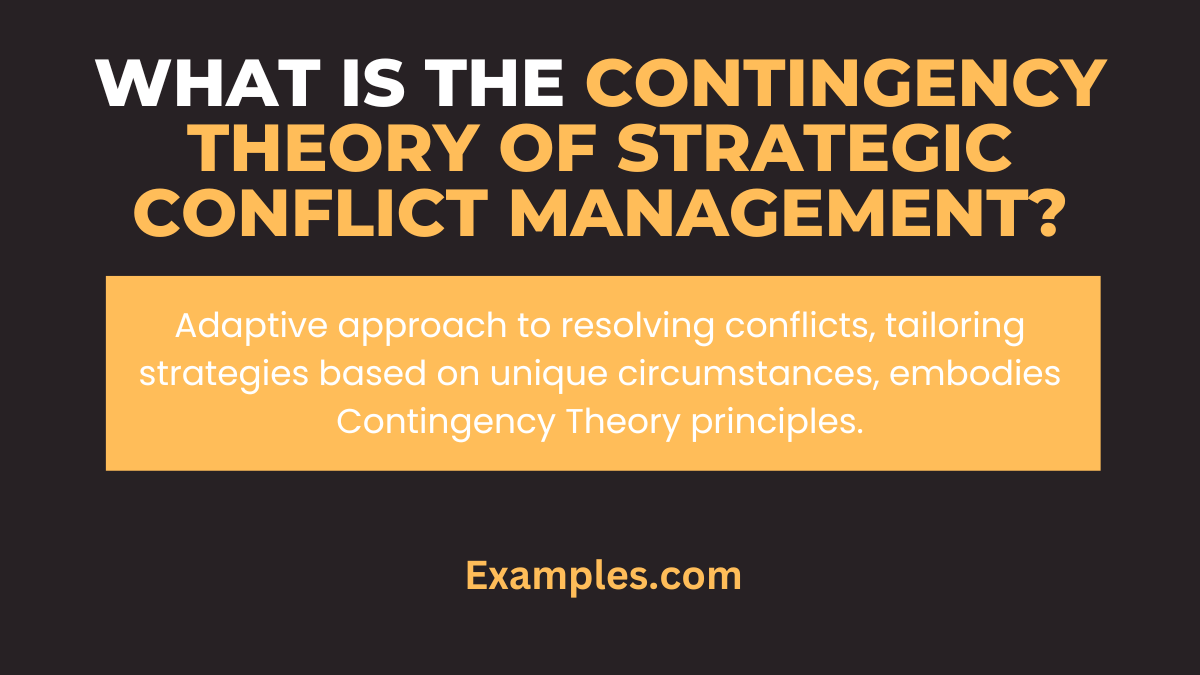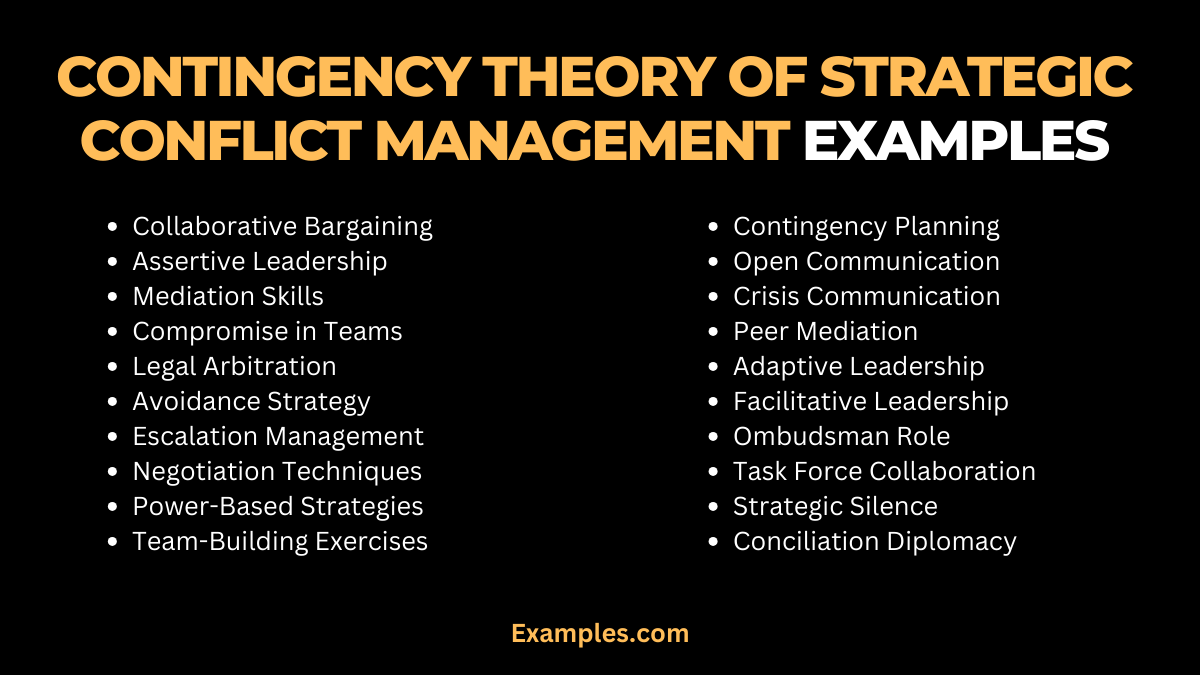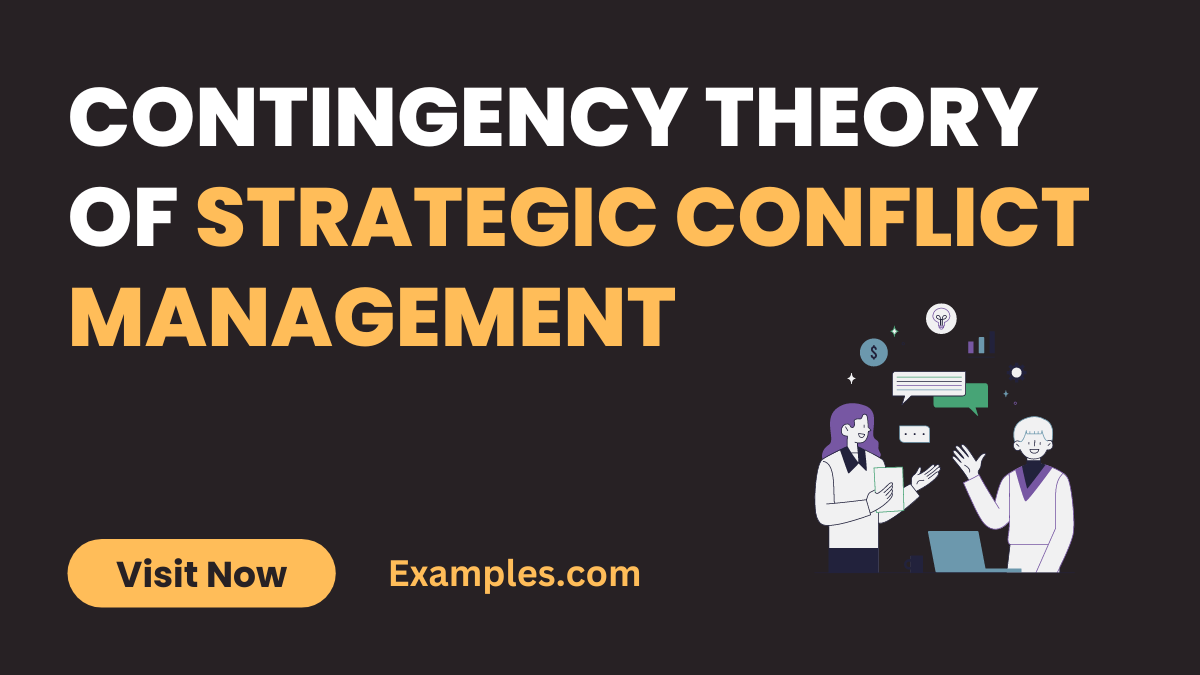Contingency Theory of Strategic Conflict Management
Unlock the strategic realm of conflict resolution with the comprehensive guide on the Contingency Theory of Strategic Conflict Management. Delve into this insightful resource for a profound understanding of conflict dynamics, backed by real-world examples and expert tips. Uncover how effective communication examples play a pivotal role in implementing this theory, steering conflicts towards resolution and fostering a harmonious environment within any organizational setting. Let’s explore the transformative power of strategic conflict management.
What is the Contingency Theory of Strategic Conflict Management

In simple terms, the Contingency Theory of Strategic Conflict Management is an approach acknowledging that conflicts vary, demanding tailored strategies for resolution. This theory emphasizes adapting conflict management techniques based on the unique circumstances of each situation. It advocates for flexibility, asserting that the most effective conflict management approach depends on the specific context, fostering a nuanced and dynamic approach to handling conflicts within organizations.
What is the Best Example of Contingency Theory of Strategic Conflict Management?

The airline industry’s labor dispute serves as a compelling example of the Contingency Theory of Strategic Conflict Management. Faced with escalating tensions, airline management embraced a flexible approach. Initially, they opted for collaborative negotiations, emphasizing shared goals. However, as the situation evolved, a shift towards a more assertive stance became necessary. The contingent strategy, adapting to the escalating conflict dynamics, showcases the theory’s efficacy in tailoring responses based on the unique circumstances of each conflict.
20 Examples of Contingency Theory of Strategic Conflict Management

Explore 20 compelling instances illustrating the Contingency Theory of Strategic Conflict Management. This curated collection goes beyond theory, offering insights into real-world scenarios where adaptive strategies become paramount in fostering effective conflict resolution.
- Collaborative Bargaining: In non-hostile scenarios, initiate open dialogues for mutual agreement through shared interests.
- Assertive Leadership: When immediate action is needed, employ assertiveness to address conflicts decisively and prevent escalation.
- Mediation Skills: A neutral third party aids conflicting parties, guiding them toward mutually agreeable solutions.
- Compromise in Teams: Encourage team members to find middle ground, ensuring collective success without undue conflict.
- Legal Arbitration: In legal conflicts, seek resolution through a neutral arbitrator, ensuring fair and legal outcomes.
- Avoidance Strategy: When conflicts are trivial or risk escalation, strategically avoid confrontation for minimal impact.
- Escalation Management: For severe conflicts, manage the escalation process systematically to avoid irreversible damage.
- Negotiation Techniques: Apply various negotiation methods based on the conflict’s nature and involved parties.
- Power-Based Strategies: Assert authority when necessary, using power-based approaches to resolve conflicts efficiently.
- Team-Building Exercises: Proactively foster team cohesion to prevent conflicts or address them constructively.
- Contingency Planning: Preventive strategies to mitigate potential conflicts, preparing for various scenarios.
- Open Communication: Transparently address concerns, ensuring open lines of communication to resolve conflicts swiftly.
- Crisis Communication: Employ clear and concise communication during crises, adapting strategies to the severity of the conflict.
- Peer Mediation: In educational settings, empower peers to mediate conflicts among students for a harmonious environment.
- Adaptive Leadership: Leaders must adapt their approach, employing different strategies as conflicts evolve.
- Facilitative Leadership: Guide groups toward consensus by facilitating open discussions and collaboration.
- Ombudsman Role: Designate an ombudsman to confidentially address conflicts, ensuring impartial resolution.
- Task Force Collaboration: Form task forces to address specific conflicts with diverse skill sets and perspectives.
- Strategic Silence: In certain situations, silence can be a powerful strategic response, allowing tensions to cool.
- Conciliation Diplomacy: Diplomatically intervene to reconcile conflicting parties, fostering peaceful resolutions.
Contingency Theory of Strategic Conflict Management Examples at Workplace
Unravel the application of Contingency Theory in workplace conflicts, where adaptability is key. Explore how tailored strategies harmonize team dynamics, ensuring effective conflict resolution in diverse professional settings.
- Task Delegation: When conflicts arise due to workload, employ flexible task delegation for equitable distribution.
- Team Empowerment: In collaborative projects, empower teams to resolve conflicts internally through shared decision-making.
- Leadership Intervention: For interpersonal conflicts, leaders may intervene assertively or adopt a facilitative role based on the situation.
- Customized Training: Implement conflict resolution training programs tailored to address specific workplace challenges.
- Feedback Mechanisms: Establish open feedback channels, adapting communication styles to suit various team members.
Contingency Theory of Strategic Conflict Management Examples for Business
In the business arena, Contingency Theory becomes a dynamic tool for conflict management. Tailored strategies navigate complexities, ensuring conflicts are resolved with precision, contributing to organizational resilience.
- Contract Negotiation: In contractual conflicts, adapt negotiation approaches based on the legal intricacies and parties involved.
- Supplier Relationship: Maintain adaptive supplier relations, employing different strategies for varied supplier conflicts.
- Market Expansion Conflicts: Navigate conflicts during market expansions by adapting strategies to diverse cultural and regulatory landscapes.
- Financial Dispute Resolution: Adapt financial conflict resolutions based on the severity and financial implications involved.
- Strategic Partnership Conflicts: For conflicts in partnerships, adapt strategies to the nature and goals of each strategic alliance.
Why is the Contingency Theory of Strategic Conflict Management Important?
Discover the pivotal role of Contingency Theory in conflict management. This guide explores its importance in fostering adaptive strategies for resolving conflicts effectively and maintaining organizational harmony.
- Adaptability: Tailoring strategies to the unique nature of each conflict.
- Effective Resolution: Ensuring conflicts are addressed with precision.
- Organizational Resilience: Navigating diverse conflict scenarios for long-term stability.
- Enhanced Communication: Strategies that optimize communication in conflict scenarios.
What are Contingency Theory of Strategic Conflict Management Strategies?
Delve into the diverse strategies of Contingency Theory for effective conflict management. Explore how tailored approaches contribute to harmonious resolutions in varied conflict scenarios.
- Task Delegation: Equitably distributing tasks to manage workload conflicts.
- Team Empowerment: Allowing teams to resolve internal conflicts through shared decision-making.
- Leadership Intervention: Leaders adopting assertive or facilitative roles based on the situation.
- Customized Training: Implementing conflict resolution programs tailored to workplace challenges.
- Feedback Mechanisms: Establishing open feedback channels, adapting communication styles for diverse team members.
What are the Principles of Contingency Theory of Strategic Conflict Management?
Uncover the foundational principle of Contingency Theory, emphasizing the need for adaptive conflict management strategies. Explore how its principles guide professionals in navigating diverse conflict scenarios.
- Adaptation: Strategies vary based on the unique nature of each conflict.
- Tailored Approaches: Crafting solutions based on the specifics of the conflict at hand.
- Situational Dynamics: Adapting to the evolving dynamics of conflicts for precision.
- Strategic Precision: Employing strategies aligned with organizational goals and conflict severity.
- Organizational Harmony: Ensuring conflict management strategies contribute to overall workplace harmony.
In conclusion, Contingency Theory of Strategic Conflict Management stands as a dynamic guide for navigating workplace conflicts. This comprehensive guide explores the theory’s vital importance, diverse strategies, and foundational principles. By emphasizing adaptability and precision in conflict resolution, professionals can foster harmonious workplaces and fortify organizations against the complexities of diverse conflict scenarios.



